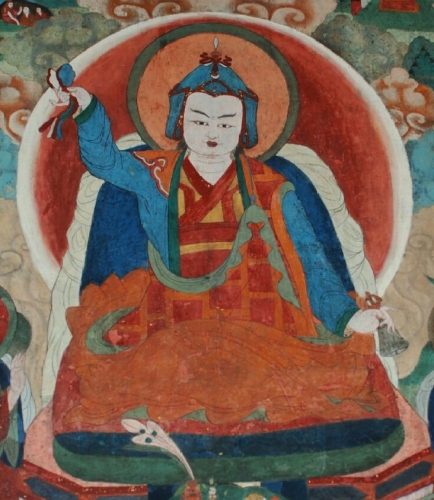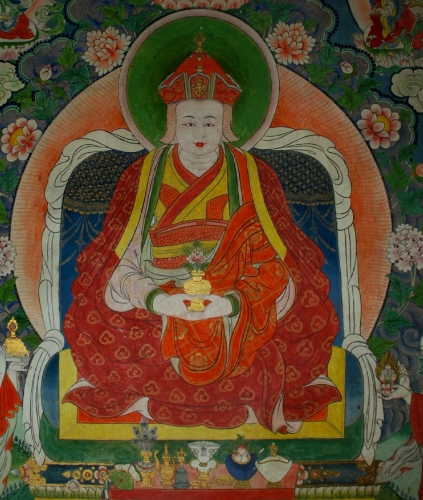Biography and autobiography in Tibet are important sources for both education and inspiration. Tibetans have kept such meticulous records of their teachers that thousands of names are known and discussed in a wide range of biographical material. All these names, all these lives—it can be a little overwhelming. The authors involved in the Treasury of Lives are currently mining the primary sources to provide English-language biographies of every known religious teacher from Tibet and the Himalaya, all of which are organized for easy searching and browsing. Every Tuesday on the Tricycle blog, we will highlight and reflect on important, interesting, eccentric, surprising and beautiful stories found within this rich literary tradition.
Bhutan’s Nyingma Treasure Revealers

The Kingdom of Bhutan—wedged between Tibet, India, Sikkim, and Nepal—is home to strong Nyingma and Drukpa Kagyu traditions. The latter is so strong that the country—Druk in the native tongue—is named for it. Several centuries before the Drukpa Kagyu dominated the country, however, two remarkable Nyingma treasure revealers, one from Tibet and one native born—Dorje Lingpa (1346–1405) and Pema Lingpa (1450–1521)—made a lasting impact on the religious landscape of the country.
Dorje Lingpa was born in southern Tibet in 1346 to yogi parents who died when he was young. At the age of 13 he started revealing treasures, among them an inventory of the scriptures and liturgies which he was destined to bring forth. It seems that by the age of 20, Dorje Lingpa had revealed so many ritual texts and objects that people were calling him a madman. In a dream he received a command from Vairocana, the eighth-century saint, telling him to go south where he would find both further treasure and converts. In 1370 he arrived in Paro, the region that is today Bhutan, and promptly began revealing treasure there.
He moved around the region gaining a wide following with the practice he originated known as “public revelation,” where an audience is invited to witness the extraction of the treasure object—a piece of scroll to be deciphered or a relic or statue. In 1371 he is said to have twice revealed treasure with three hundred people in attendance. After seven years, having sired a son there named Choying, he went back to Tibet, where he was accused of having been corrupted by the southern “barbarians.” Responding to the prejudice, Dorje Lingpa attended a ceremony accompanied by women wearing tiger and leopard masks, and singing songs about the dangers of dualistic thinking. The songs continue to account for a large part of his legacy, which was ensured through the teaching lineages of his students, which include the Fourth Karmapa, Rolpai Dorje (1340–1383) and his family lineage, which continues to this day in Bhutan.
Some fifty years after Dorje Lingpa passed away, his son Choying received a child to bless, a young boy who would later be known as Pema Lingpa. Pema Lingpa was born in a region known as Bumthang, now a province in north-central Bhutan, to a family that claimed descent from a son of Jikten Gonpo (1143–1217), the founder of the Drigung Kagyu tradition. He was apprenticed to his grandfather, a blacksmith, and quickly learned the crafts of making chain mail, knives, and cooking implements. Later detractors would cite this fact in claiming that Pema Lingpa himself crafted the many metal treasure caskets and objects that he purportedly discovered.

At the age of 27, Pema Lingpa was visited in a dream by a shabbily dressed monk who urged him to read a small scroll in his outstretched hand. The scroll commanded that Pema Lingpa go with five friends to a specific cliff during the night of the full moon to reveal a treasure. Although his father dismissed this, his mother encouraged him to go, and so he went to the place, Naring Drak, where he stripped naked and dove into a small lake below the cliff. It is said that there he found a large underwater cave, and upon entering, spotted a throne and a stack of texts. The guardian of the cave took one of the texts and pushed it towards Pema Lingpa, telling him to run. This was the first of the 32 treasures he would reveal.
Pema Lingpa’s career was shadowed by considerable controversy. Not all were convinced of his authenticity, and he frequently had to enact public extractions to prove himself, once diving into the same lake where he first revealed treasure with a lighted butter lamp and emerging with a treasure casket, lamp still burning. The lake is known as Mebartso—”burning lake.” In 1483 he revealed one of his best-known treasures, the Lama Norbu Gyatso cycle, in southern Tibet.
Having achieved widespread fame, he established a temple seat in 1501, Tamzhing Lhundrub Choling Lhakhang in Chokhor. Among his disciples and peers with whom he exchanged teachings were Drukpa Kunlek (1455–1529), the Seventh Karmapa, Chodrak Gyatso (1454–1506), the First Yolmo Tulku Shakya Zangpo (d.u.), Drakpa Gyeltsen (d.u.), Dawa Gyeltsen (1499–1587), and his own two sons. He died at Tamzhing in 1521.
Pema Lingpa remains a controversial figure to this day. Michael Aris, the deceased husband of Burmese democracy activist Aung San Suu Kyi, authored a book titled Hidden Treasures and Secret Lives (1989), wherein Aris claims that Pema Lingpa was a charlatan who staged all his revelations for his own aggrandizement. At that time Aris was the private tutor for the children of the royal family of Bhutan, but was nevertheless banned from the country upon the book’s publication.
Pema Lingpa’s transmission lineage is passed down through three primary lines of incarnations: the Peling Sungtrul, the Peling Tukse, and the Peling Gyelse, also known as the Gangteng Tulku. These three lines were initially interconnected through reincarnation and hereditary relations, though their early history is somewhat confused. They represent the strongest sects of the Nyingma tradition in modern-day Bhutan.
You can read full biographies of Dorje Lingpa, Pema Lingpa, and most of the Peling Sungtrul, Peling Tukse, and Gangteng incarnations at the Treasury of Lives.
Thank you for subscribing to Tricycle! As a nonprofit, we depend on readers like you to keep Buddhist teachings and practices widely available.